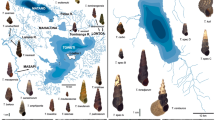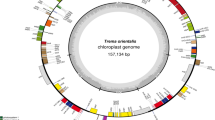Abstract
In order to clarify evolutionary patterns and processes of intraspecific diversification ofPedicularis chamissonis Steven, we analyzed intraspecific variation of the nucleotide sequences of non-coding regions of chloroplast DNA: the intergenic spacers betweentrnT (UGU) andtrnL (UAA) 5′exon,trnL (UAA) 3′exon andtrnF (GAA), andatpB andrbcL. In 24 populations ofP. chamissonis, 33 nucleotide substitutions and 12 insertions/deletions were inferred, and their genetic distances ranged from 0.001 to 0.014. Seventeen distinct cpDNA haplotypes could be recognized and each haplotype was found to be geographically structured. Two major clades (the Northern and Southern clades) were revealed in phylogenetic analyses of cpDNA haplotypes. The haplotypes of the Northern clade had a wider distribution area in the populations of Mts. lide of central Honshu in Japan, northward to Unalaska Island in the Aleutians. Relationships among most haplotypes were unresolved polytomies. On the other hand, the haplotypes of the Southern clade occurred from the populations of Mt. Gassan southwards to Mt. Arakawa of central Honshu. Within this clade, three subclades were clearly recognized. From these results, we concluded that the haplotypes of the Northern and Southern clades inP. chamissonis might have traveled down to Japanese Archipelago from the north in not a single glacial period.
Similar content being viewed by others
References
Adachi, J. andHasegawa, M. 1996. MOLPHY: Programs for Molecular Phylogenetics version 2.3b3. Institute of Statistical Mathematics, Tokyo.
Avise, J.C. 1994. Molecular markers, natural history and evolution. Chapman and Hall, New York.
Avise, J.C., Arnold, J., Ball, R.M., Bermingham, E., Lamb, T., Neigel, J.E., Reeb, C.A. andSaunders, N.C. 1987. Intraspecific phytogeography: The mitochondrial DNA bridge between population genetics and systematics. Ann. Rev. Ecol. Syst.18: 489–522.
Doyle, J.J. andDickson, E.E. 1987. Preservation of plant samples for DNA restriction endonuclease analysis. Taxon36: 715–722.
Fujii, N., Ueda, K., Watano, Y. andShimizu, T. 1995. Intraspecific sequence variation in chloroplast DNA ofPrimula cuneifolia Ledeb. J. Phytogeogr. & Taxon43: 15–24.
Hara, H. 1948. A bibliographic enumeration of flowering plants indigenous to or long cultivated in Japan and its adjacent islands. Iwanami shoten, Tokyo.
Hasegawa, M., Kishino, H. andYano, T. 1985. Dating of the human-ape splitting by a molecular clock of mitochondrial DNA. J. Mol. Evol.22: 160–174.
Hultén, E. 1930.Pedicularis chamissonis.In E. Hultén, Flora of Kamchatka and the Adjacent Islands 4, Almqvist and Wiksells, Stockholm, pp 109–111.
Kawano, S. 1971. Studies on the alpine flora of Hokkaido, Japan I. phytogeography. J. Coll. Lib. Arts, Toyama Univ. Nat. Sci.4: 13–96.
Kimura, M. 1980. A simple method for estimating evolutionary rates of base substitutions through comparative studies of nucleotide sequences. J. Mol. Evol.16: 111–120.
Kita, Y., Ueda, K. andKadota, Y. 1995. Molecular phylogeny and evolution of the AsianAconitum subgenusAconitum (Ranunculaceae). J. Plant Res.108: 429–442.
Kitamura, S., Murata, G. andHori, M. 1958. Colored Illustrations of Herbaceous Plants of Japan vol. 1 (Sympetalae), rev. ed. Hoikusha, Osaka. (in Japanese)
Koidzumi, G. 1919. Genetic and floristic phytogeography of thealpine flora of Japan. Bot. Mag. Tokyo33: 193–222. (in Japanese)
Minato, M. andIjiri, S. 1976. The Japanese Archipelago. 3rd ed., Iwanamishoten, Tokyo. (in Japanese)
O'Donnell, K. 1992. Ribosomal DNA internal transcribed spacers are highly divergent in the phytopathogenic ascomycetaFusarium sambucinum (Gibberella pulicaris). Curr. Genet.22: 213–220.
Ohwi, J. 1978. Flora of Japan, rev. and enlarg. ed. Shibundo, Tokyo. (in Japanese)
Orita, M., Iwahara, H., Kanazawa, H., Hayashi, K. andSekiya, T. 1989a. Detection of polymorphisms of human DNA by gel electrophoresis as single-strand conformation polymorphisms. Proc. Natl. Acad. Sci. USA86: 2771–2774.
Orita, M., Suzuki, Y., Sekiya, T. andHayashi, K. 1989b. Rapid and sensitive detection of point mutations and DNA polymorphisms using the polymerase chain reaction. Genomics5: 874–879.
Shimizu, T. 1982. The new alpine flora of Japan in color vol. 1. Hoikusha, Osaka. (in Japanese)
Soltis, D.E., Mayer, M.S., Soltis, P.S. andEdgerton, M. 1991. Chloroplast DNA variation inTellima grandiflora (Saxifragaceae). Amer. J. Bot.78: 1379–1390.
Soltis, D.E. andSoltis, P.S. andMilligan, B.G. 1992a. Intraspecific chloroplast DNA variation: Systematics and phylogenetic implication.In P.S. Soltis, D.E. Soltis and J.J. Doyle, eds., Molecular Systematics of Plants, Chapman and Hall, New York, pp. 117–150.
Soltis, D.E., Soltis, P.S., Kuzoff, R.K. andTucker, T.L. 1992b. Geographic structuring of chloroplast DNA genotypes inTiarella trifoliata (Saxifragaceae). Pl. Syst. Evol.181: 203–216.
Soltis, D.E., Soltis, P.S., Ranker, T.A. andNess, B.D. 1989. Chloroplast DNA variation in a wild plant,Tolmiea menziesii. Genetics121: 819–826.
Swofford, D.L. 1993. PAUP: Phylogenetic Analysis Using Parsimony version 3.1.1. The Illinois Natural History Survey, Champaign.
Taberlet, P., Gielly, L., Pautou, G. andBouvet, J. 1991. Universal primers for amplification of three non-coding regions of chloroplast DNA. Pl. Mol. Bio.17: 1105–1109.
Terachi, T. 1993. Structural alterations of chloroplast genome and their significance to the higher plant evolution. Bull. Inst. Natl. Land Util. Developm. Kyoto Sangyo Univ.14: 138–148.
Thompson, J.D., Higgins, D.G. andGibson, T.J. 1996. Clustal W version 1.6. EMBL, Heidelberg.
Toyokuni, H. 1981. A preliminary note on the floristic phytogeography of the alpine flora of Japan. J. Fac. Lib. Arts, Shinshu Univ. Nat. Sci.15: 81–96.
Yamazaki, T. 1982. Nomenclatural changes and new taxa of some Scrophulariaceae plants in Japan. J. Jap. Bot.57: 212–215. (in Japanese with Latin description)
Yamazaki, T. 1987. A new variety ofPedicularis chamissonis Steven. J. Jap. Bot.62: 54. (in Japanese with Latin description)
Yamazaki, T. 1993.Pedicularis.In K. Iwatsuki, T. Yamazaki, D.E. Boufford and H. Ohba, eds., Flora of Japan, vol. 3a. Kodansha, Tokyo. pp. 364–371.
Watano, Y., Imazu, M. andShimizu, T. 1995. Chloroplast DNA typing by PCR-SSCP in thePinus pumila-P. parviflora var.pentaphylla complex (Pinaceae). J. Plant Res.108: 493–499.
Author information
Authors and Affiliations
Rights and permissions
About this article
Cite this article
Fujii, N., Ueda, K., Watano, Y. et al. Intraspecific sequence variation of chloroplast DNA inPedicularis chamissonis Steven (Scrophulariaceae) and geographic structuring of the Japanese “Alpine” plants. J. Plant Res. 110, 195–207 (1997). https://doi.org/10.1007/BF02509308
Received:
Accepted:
Issue Date:
DOI: https://doi.org/10.1007/BF02509308




